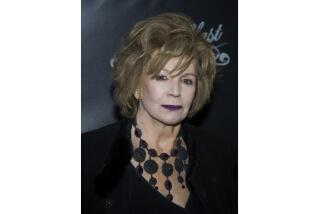Book Review : The Options of Liberation Women Face
- Share via
Her Native Colors by Elisabeth Hyde (Delacorte: $15.95)
This story of two young women who grew up in a small Vermont town believing their girlhood friendship would endure forever is a model post-feminist novel; a category bound to be jammed by the end of the decade. Appearing just as nonfiction writers are taking a wintry look at the myth of women’s liberation, “Her Native Colors” explores the idea of “having it all” versus “having only some of it”; each of the two central characters realizing that she has been deluded and gulled by social pressures.
Phoebe Martin has bought the entire 1970s ideal, leaving Winslow for college in Boston and law school at Berkeley; marrying a fellow student, having a child, divorcing, working for a prestigious San Francisco law firm, struggling to reconcile the demands of single parenthood and a career. Molly Adams has remained in Vermont, teaching at the local high school, raising sheep, spinning wool, weaving wall hangings; just now hitting her stride as a serious fiber artist. As Phoebe and Molly are about to turn 30, they have begun to examine their options.
If you’re on Phoebe’s fast track, there are only a few years between the LSAT and a mid-life crisis; if, like Molly, you’ve rejected feminist propaganda and chosen a more traditional path, you’re a prime candidate for the Wasted Life Blues, though Molly seems content enough until Phoebe flies back to Vermont to be her matron of honor.
Briefcase in hand, winsome 4-year-old Andrew in tow, exuding confidence and an aura of worldly success, Phoebe manages to keep her doubts about her life firmly in check, though back home in Marin County, she constantly is questioning her values and goals. Though she fantasizes about leaving her 200-member firm for independent law practice, those thoughts are confided only to her associate Janice, mentioned only in the health club steam room. With a small child to support and a Bay view flat at stake, Phoebe knows a two-woman law partnership in a restored Victorian couldn’t provide the security she needs. Still, she keeps an up-to-date resume locked in her desk drawer, a hedge against the day the senior partner’s demands become completely outrageous.
When Molly’s unexpected wedding invitation arrives, Phoebe impulsively decides to fly back for the ceremony. She hasn’t visited Molly for six years; her mother and brother are still in Winslow. How wonderful to see her best friend married; how satisfying to show off her precocious child, bask in family pride, and perhaps prove to Molly that she has achieved everything she hoped for when they were high school idealists.
After all, Molly merely is marrying a local boy, who despite his master’s degree in literature, is working as a woodcutter. If anything could resolve Phoebe’s unsettling doubts about her own choices, Molly’s wedding seems nicely calculated to do the job. Though Phoebe actually is spending her life reading boring documents for an employer with all the compassion of Caligula, even that must be more glamorous than teaching 10th-grade science and betting on the date of the spring thaw.
The reunion gets off to a shaky start and deteriorates from there. Molly, who always had seemed happy to follow her more aggressive friend’s lead, has become less malleable; Phoebe, more abrasive as she tries to justify her own existence. Though each woman has useful lessons to impart to the other, neither is in the mood to listen or learn. Lavishing all her attention upon the conflict between Phoebe and Molly, Hyde has scanted the other characters, permitting them to become basic all-purpose Yankees. Molly’s mother and Phoebe’s are virtually indistinguishable; Duncan Crane, the dowsing engineer who takes a sudden passionate interest in Phoebe is so much like Molly’s woodcutter fiance Nick that the men seem ordered from the same catalogue of sturdy New England classics. The faculty of Molly’s school and the picturesque locals at the square dance are standard types: crotchety, taciturn, and smug.
Like the serviceable plot, the residents of Winslow provide a background for the difficulties of being a 30-year-old woman in 1986; all things theoretically possible but not simultaneously.
More to Read
Sign up for our Book Club newsletter
Get the latest news, events and more from the Los Angeles Times Book Club, and help us get L.A. reading and talking.
You may occasionally receive promotional content from the Los Angeles Times.







